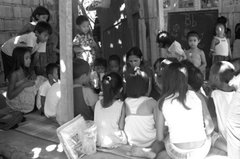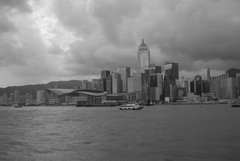
Well, I have now been in Manila two weeks!! So last week, since I had yet to
actually visit "Manila" proper, I decided to take one of Carlos's infamous tours. Of course the day of the tour it must have been at least 95 degrees and not a cloud in the sky! The tour began at San Augstin church in the heart of intramuros. (The remaining walled part of the downtown of Manila, (i.e. the original city)
 Intramuros
Intramuros The things I learned about Philippines history (though from the Philippine perspective, I will note) of which we learned absolutely nothing about in school, even though we (the US) were one of the two colonists. I will however note to the United States credit. It developed the Philippine education system, much of Manila's infrastructure, and the trade routes.Though, to much the United States detriment, in 1946, they bombed Manila completely devastating and destroying much of what they had helped create. Killing over 150,000 total, the United States rationale being, they had to defend the Philippines from the Japanese. Yet, to me the question more to the point is how in the world did the Philippines end up in WWII?? I will leave this up to those who would like to read more on Filipino's more recent history.
Also, take a look at the link to the tour guide's website (Carlos). He has some interesting historical pictures and background which will probably add to most of our historical perspectives.
Casa Manila

We then went to Casa Manila (which is a replica built 20 years ago) by the infamous Imelda Marcus. All the original Casas were of course destroyed by the bombing in 46.
Here are a few pictures of the Casa. The name Casa comes from the Spanish meaning "house" (I believe this is right, not sure?). The Spanish of course were the colonists before the United States. Though as our tour guide pointed out, when the Spanish came in the 1600's they quickly gave the Philippines "up" to the church believing that the islands had nothing of worth (i.e. no gold). So, the Philippines was never considered a colony, but a "extended" part of Mexico. It was thought to be at the "end" of the earth!!
There was so so much information packed into the tour, there is no way my brain could take in even a fourth of the information. Though, I will say that often I go on tours and because they are not very exciting to say the least, I don't remember one little iota of information, but this guy was extremely gifted at keeping even the most sever attention deficient person interested!!!






2 comments:
Hmm... the buildings are very European to me. Todd said they do not even have lots local food, yet with many adopted from the period of Spainish colony. True?
Well, some has been taken from the Spanish colonization. But there are many local dishes using the local vegetables and fresh fish. And yes, they love their meat and rice. A meal is not complete with rice (don't think that is very Spanish:))
Post a Comment